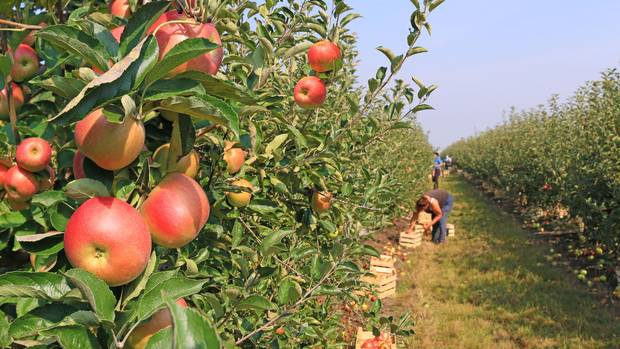Top Stories
Combatting Codling Moths: Effective Solutions for Apple Growers

Codling moths are a significant concern for apple growers, particularly in regions like New Zealand. These pests target young, fertilised apples, known as codlings, shortly after flowering. The female moth lays its eggs in the developing fruit, and once the caterpillars hatch, they tunnel inside, causing extensive damage. This damage is often accompanied by fungal infections, leading to unsightly decay and “frass” protruding from the fruit. Once the caterpillars penetrate the apple, the affected fruit becomes unmarketable.
Historically, apple growers relied on harsh insecticides such as Carbaryl and Organophosphates to manage codling moth populations. These chemicals, while effective, raised concerns regarding environmental safety and health implications. Fortunately, there are now more sustainable alternatives available.
Identifying the codling moths is crucial for effective management. They are visually striking, typically measuring about one centimetre in length and displaying golden colours. After the caterpillars mature, they exit the fruit, descend the tree, and pupate in loose bark or soil. In northern parts of New Zealand, a second generation of moths emerges during the summer months. Growers can monitor these populations using pheromone traps specifically designed for codling moths, which indicate when the pests are active and searching for apples on which to lay their eggs.
While these traps can capture some moths, they are insufficient for significant population control. For a more effective solution, growers are turning to a specific virus known as MADEX 3, which primarily targets codling moth caterpillars. This Granulosis Virus has proven to be both effective and safe for use in orchards, as it does not harm other insect species.
MADEX 3 is a commercial product widely used by apple growers, particularly in larger orchards. It is available through various suppliers, including online retailers like Good to Grow and NZ YUZU, as well as commercial distributors like Farmlands, PGG Wrightson, Fruit Fed Supplies, and Horti Centre. While the cost of MADEX 3 is approximately $180 for 100 ml, proper storage can extend its shelf life significantly. Growers are advised to keep the product in the freezer and only use the required amount to make it last for future applications.
As the season progresses, apple growers are encouraged to prepare to deploy MADEX 3 in the coming weeks. Following the instructions and potentially sharing the costs with neighbouring growers can enhance the effectiveness of this solution while mitigating expenses. With integrated pest management strategies like these, apple growers can protect their crops from the damaging effects of codling moths, ensuring the quality and yield of their harvests.
-

 World4 months ago
World4 months agoTest Your Knowledge: Take the Herald’s Afternoon Quiz Today
-

 Sports4 months ago
Sports4 months agoPM Faces Backlash from Fans During Netball Trophy Ceremony
-

 Lifestyle4 months ago
Lifestyle4 months agoDunedin Designers Win Top Award at Hokonui Fashion Event
-

 Entertainment5 months ago
Entertainment5 months agoExperience the Excitement of ‘Chief of War’ in Oʻahu
-

 Sports4 months ago
Sports4 months agoLiam Lawson Launches New Era for Racing Bulls with Strong Start
-

 World5 months ago
World5 months agoCoalition Forms to Preserve Māori Wards in Hawke’s Bay
-

 Health4 months ago
Health4 months agoWalking Faster Offers Major Health Benefits for Older Adults
-

 Lifestyle4 months ago
Lifestyle4 months agoDisney Fan Reveals Dress Code Tips for Park Visitors
-

 Politics4 months ago
Politics4 months agoScots Rally with Humor and Music to Protest Trump’s Visit
-

 Top Stories5 months ago
Top Stories5 months agoUK and India Finalize Trade Deal to Boost Economic Ties
-

 Health2 months ago
Health2 months agoRadio Host Jay-Jay Feeney’s Partner Secures Visa to Stay in NZ
-

 World5 months ago
World5 months agoHuntly Begins Water Pipe Flushing to Resolve Brown Water Issue









